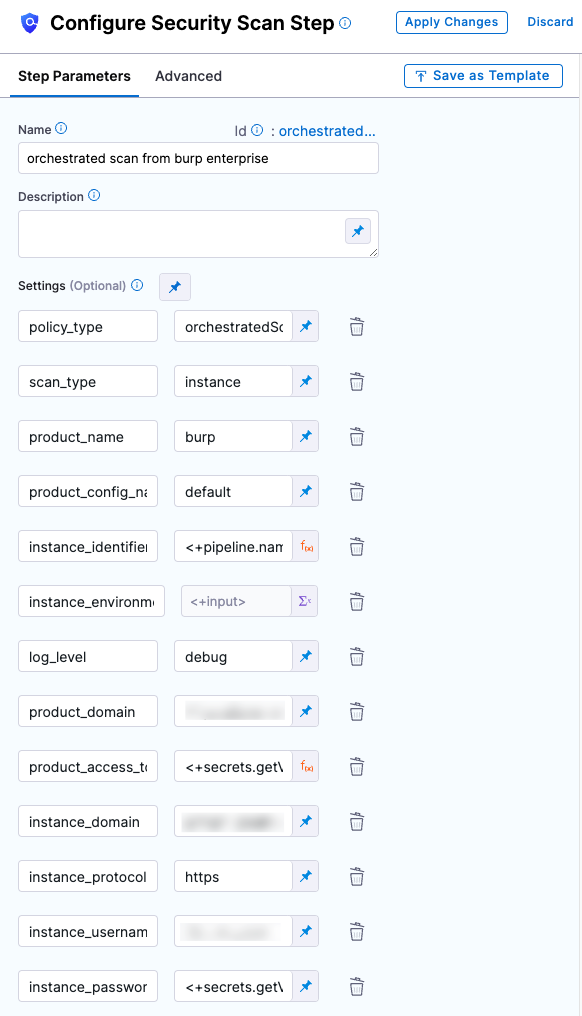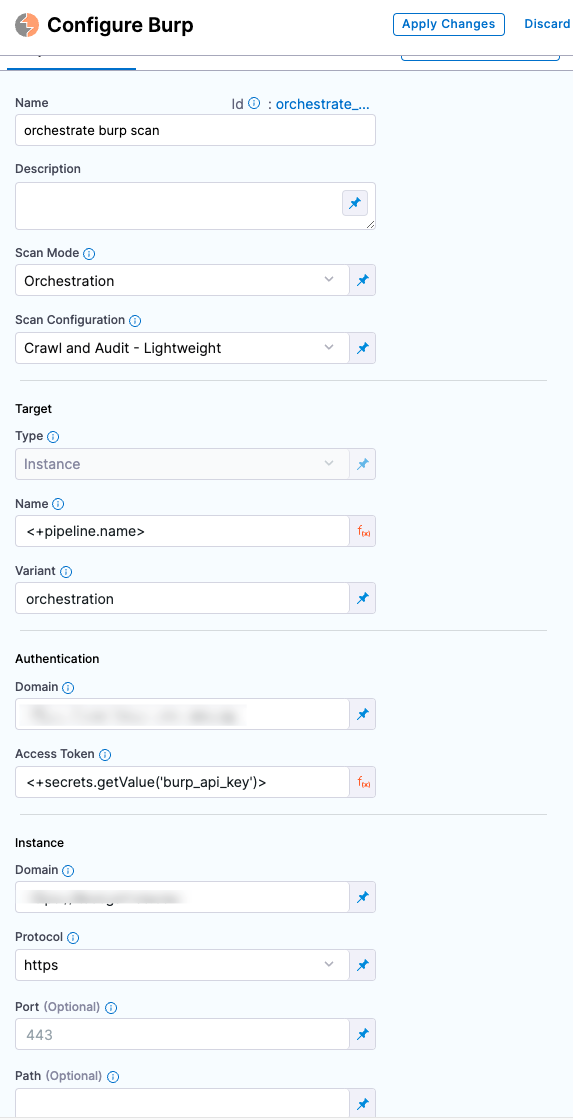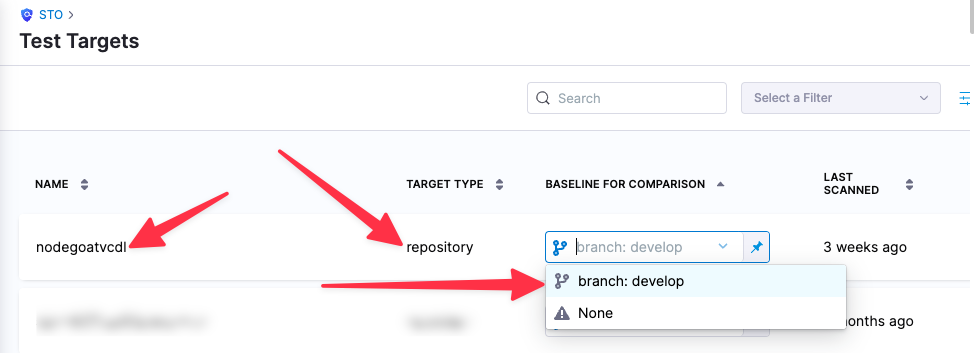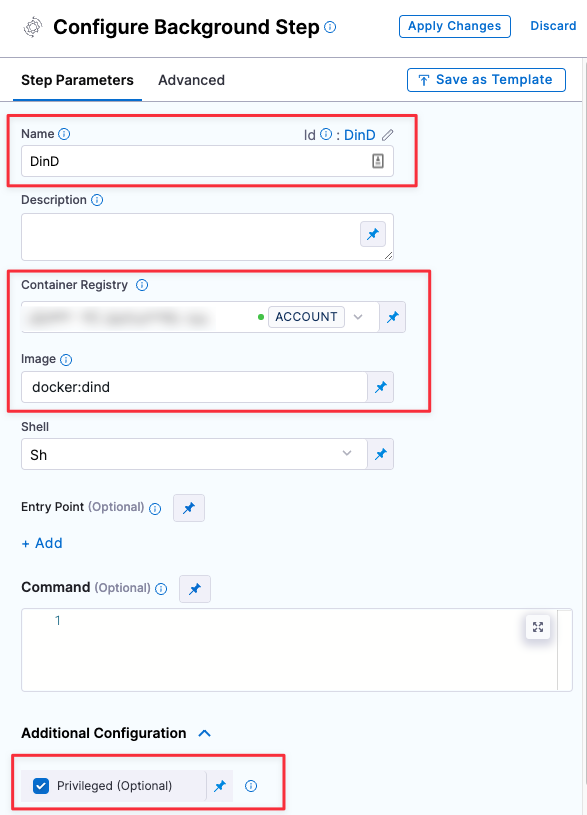Burp scanner reference
You can scan your application instances automatically using Burp Enterprise.
To set up a Burp scan:
- Create a CI Build or Security Tests stage,
- Add a Burp or a Security
- Configure the step as specified in the following sections.
Burp scan configuration in Security step

Before you begin
Root access requirements
You need to run the scan step with root access if either of the following apply:
You need to run a Docker-in-Docker background service.
You need to add trusted certificates to your scan images at runtime.
You can set up your STO scan images and pipelines to run scans as non-root and establish trust for your own proxies using self-signed certificates. For more information, go to Configure STO to Download Images from a Private Registry.
Burp step configuration
Currently, this feature is behind the Feature Flag STO_STEP_PALETTE_BURP_ENTERPRISE. Contact Harness Support to enable the feature.
Orchestrated scan in a Burp scanner template

Scan settings
Scan Mode
The orchestration mode to use for the scan. The following list includes the UI and YAML values for the supported options.
- Orchestrated A fully-orchestrated scan. A Security step in the Harness pipeline orchestrates a scan and then normalizes and compresses the results.
- Ingestion Ingestion scans are not orchestrated. The Security step ingest results from a previous scan (for a scan run in an previous step) and then normallizes and compresses the results.
Scan Configuration
The predefined configuration to use for the scan. All scan steps have at least one configuration.
The following configurations are available for Orchestrated scans. These are built-in configurations provided by Burp Enterprise.
DefaultThis is the same as theCrawl and Audit - Lightweightbuilt-in configuration.Never stop Crawl due to application errorsNever stop audit due to application errorsMinimize false positivesMinimize false negativesCrawl strategy most completeCrawl strategy more completeCrawl strategy fastestCrawl strategy fasterCrawl limit 60 minutesCrawl limit 30 minutesCrawl limit 10 minutesCrawl and audit lightweightCrawl and audit fastCrawl and audit deepCrawl and audit balancedAudit coverage thoroughAudit coverage maximumAudit checks medium activeAudit checks light activeAudit checks critical issues onlyAudit checks all except time based detection methodsAudit checks all except java script analysis
Target settings
Make sure that you give unique, descriptive names for the target and variant. This makes navigating your scan results in the STO UI much easier.
Type
- Instance Scan a running application.
Name
The Identifier that you want to assign to the target you’re scanning in the pipeline. Use a unique, descriptive name such as codebaseAlpha or jsmith/myalphaservice. Using descriptive target names will make it much easier to navigate your scan data in the STO UI.
Variant
An identifier for a specific variant to scan, such as the branch name or image tag. This identifier is used to differentiate or group results for a target. Harness maintains a historical trend for each variant.
You can see the target name, type, and variant in the Test Targets UI:

Make sure that you give unique, descriptive names for the target and variant. This makes navigating your scan results in the STO UI much easier.
Authentication settings
Domain
Domain of the application instance to scan. Example: https://myapp.io/portal/us
Access Token
The access token used to log in to a specific product in the scanner. This is required for some scans. In most cases, this is a password or an API key.
You should create a Harness text secret with your encrypted token and reference the secret using the format <+secrets.getValue("project.container-access-id")>. For more information, go to Add and Reference Text Secrets.
Scan Tool
Use this setting to specify a specific scan to ingest. If this is not specified, the pipeline ingests the most recent scan.
Instance settings
Domain
Domain of the application instance to scan. You can include the full path to the app in this field, or split the full path between the Domain and the Path fields. Example: https://myapp.io/portal/us
Protocol
HTTPS (default) or HTTP.
Port
The TCP port used by the scanned app instance.
Path
Path to append to the application instance domain, if you're splitting the full path between the Domain and Path settings. For example, you might specify the domain as https://myapp.io and the path as /portal/us.
Username
Username to log in to the instance you want to scan.
Password
The access token to log in to the instance you want to scan. In most cases, this is a password or an API key.
You should create a Harness text secret with your encrypted token and reference the secret using the format <+secrets.getValue("project.container-access-id")>. For more information, go to Add and Reference Text Secrets.
Ingestion File
The results data file to use when running an Ingestion scan. STO steps can ingest scan data in SARIF and Harness Custom JSON format. Generally an Ingestion scan consists of a scan step (to generate the data file) and an ingestion step (to ingest the data file).
Security step settings (deprecated)
Docker-in-Docker requirements
Docker-in-Docker is not required for ingestion workflows where the scan data has already been generated.
You need to include a Docker-in-Docker background service in your stage if either of these conditions apply:
- You configured your scanner using a generic Security step rather than a scanner-specific template such as Aqua Trivy, Bandit, Mend, Snyk, etc.
- You’re scanning a container image using an Orchestration or Extraction workflow.
Set up a Docker-in-Docker background step
Go to the stage where you want to run the scan.
In Overview, add the shared path
/var/run.In Execution, do the following:
- Click Add Step and then choose Background.
- Configure the Background step as follows:
- Dependency Name =
dind - Container Registry = The Docker connector to download the DinD image. If you don't have one defined, go to Docker connector settings reference.
- Image =
docker:dind - Under Optional Configuration, select the Privileged checkbox.
- Dependency Name =

Target and variant
The following settings are required for every Security step:
target_nameA user-defined label for the code repository, container, application, or configuration to scan.variantA user-defined label for the branch, tag, or other target variant to scan.
Make sure that you give unique, descriptive names for the target and variant. This makes navigating your scan results in the STO UI much easier.
You can see the target name, type, and variant in the Test Targets UI:

For more information, go to Targets, baselines, and variants in STO.
Burp scan settings
product_name=burpscan_type=instancepolicy_type=orchestratedScan,dataLoad, oringestionOnlyproduct_config_name- The following configurations are available. These are built-in configurations provided by Burp Enterprise.
defaultThis is the same as theCrawl and Audit - Lightweightbuilt-in configuration.never-stop-crawl-due-to-application-errorsnever-stop-audit-due-to-application-errorsminimize-false-positivesminimize-false-negativescrawl-strategy-most-completecrawl-strategy-more-completecrawl-strategy-fastestcrawl-strategy-fastercrawl-limit-60-minutescrawl-limit-30-minutescrawl-limit-10-minutescrawl-and-audit-lightweightcrawl-and-audit-fastcrawl-and-audit-deepcrawl-and-audit-balancedaudit-coverage-thoroughaudit-coverage-maximumaudit-checks-medium-activeaudit-checks-light-activeaudit-checks-critical-issues-onlyaudit-checks-all-except-time-based-detection-methodsaudit-checks-all-except-java-script-analysis
- The following configurations are available. These are built-in configurations provided by Burp Enterprise.
fail_on_severity- See Fail on Severity.
Instance scan settings
The following settings apply to Security steps where the scan_type is instance.
instance_domaininstance_pathinstance_protocolinstance_portinstance_usernameThe username for authenticating with the external scanner.instance_passwordYou should create a Harness text secret with your encrypted password and reference the secret using the format<+secrets.getValue("project.container-access-id")>. For more information, go to Add and reference text secrets.
Orchestration scan settings
The following settings are required for Security steps where the policy_type is orchestratedScan.
product_domainDomain of the application instance to scan. You can include the full path to the app in this field, or split the full path between the Domain and the Path fields. Example:https://myapp.io/portal/usproduct_access_tokenThe access token used to log in to a specific product in the scanner. This is required for some scans. In most cases this is a password or an API key.You should create a Harness text secret with your encrypted token and reference the secret using the format
<+secrets.getValue("project.container-access-id")>. For more information, go to Add and Reference Text Secrets.
For a complete workflow description and example, go to Run an Orchestrated Scan in an STO Pipeline.
Dataload scan settings
The following settings are required for Security steps where the policy_type is dataLoad.
product_site_idThe Burp enterprise site identifier.product_domainDomain of the application instance to scan. Example:https://myapp.io/portal/usYou need to specify either the
product_site_idor theproduct_domain.product_scan_idUse this setting to specify a specific scan to ingest. If this is not specified, the pipeline will ingest the most recent scan.product_access_tokenThe access token used to log in to a specific product in the scanner. This is required for some scans. In most cases this is a password or an API key.You should create a Harness text secret with your encrypted token and reference the secret using the format
<+secrets.getValue("project.container-access-id")>. For more information, go to Add and Reference Text Secrets.
Ingestion file
The following setting is required for Security steps where the policy_type is ingestionOnly.
ingestion_fileThe results data file to use when running an Ingestion scan. You should specify the full path to the data file in your workspace, such as/shared/customer_artifacts/my_scan_results.json. STO steps can ingest scan data in SARIF and Harness Custom JSON format.
The following steps outline the general workflow for ingesting scan data into your pipeline:
Specify a shared folder for your scan results, such as
/shared/customer_artifacts. You can do this in the Overview tab of the Security stage where you're ingesting your data.Create a Run step that copies your scan results to the shared folder. You can run your scan externally, before you run the build, or set up the Run step to run the scan and then copy the results.
Add a Security step after the Run step and add the
target name,variant, andingestion_filesettings as described above.
For a complete workflow description and example, go to Ingest Scan Results into an STO Pipeline.
Fail on Severity
Every Security step has a Fail on Severity setting. If the scan finds any vulnerability with the specified severity level or higher, the pipeline fails automatically. You can specify one of the following:
CRITICALHIGHMEDIUMLOWINFONONE— Do not fail on severity
The YAML definition looks like this: fail_on_severity : critical # | high | medium | low | info | none